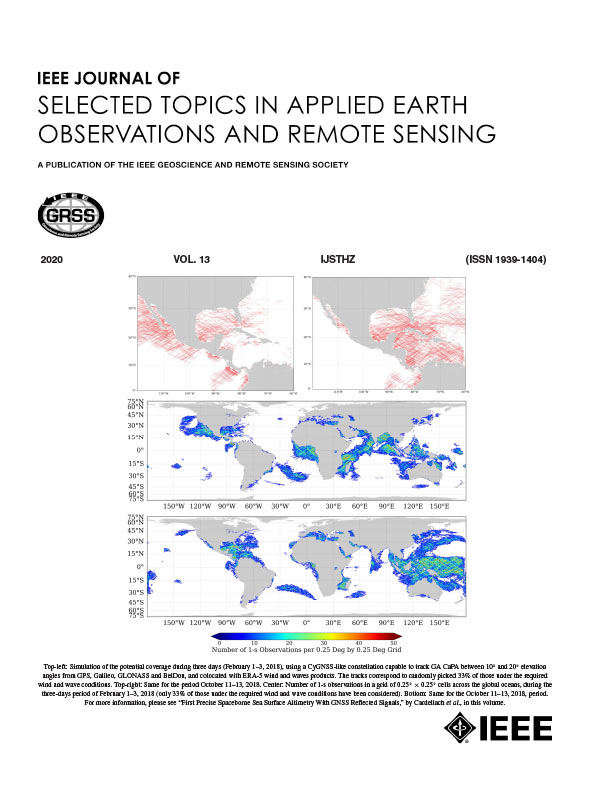根据机载海洋激光雷达的混合波形确定海陆界面
IF 4.7
2区 地球科学
Q1 ENGINEERING, ELECTRICAL & ELECTRONIC
IEEE Journal of Selected Topics in Applied Earth Observations and Remote Sensing
Pub Date : 2024-09-16
DOI:10.1109/JSTARS.2024.3462428
引用次数: 0
摘要
机载海洋激光雷达(AOL)数据中的激光波形被归类为海洋波形或陆地波形。但是,在 AOL 的大范围内,海洋和陆地可能同时存在于海洋-陆地界面 (OLI),从而产生海洋-陆地混合波形。反之,如果我们能够识别海陆混合波形,就能确定 OLI 的位置。本研究旨在识别混合红外(IR)海陆波形,并进一步提出一种利用识别出的混合红外海陆波形确定 OLI 的新方法。首先,提出了一种新型模糊卷积神经网络来对红外波形进行分类,并输出一个预测概率向量,表明波形被归类为海洋波形或陆地波形的可能性。其次,该预测概率向量用于识别海洋-陆地混合红外波形。最后,利用红外海洋-陆地混合波形和相应的激光点云确定 OLI 的位置。所提出的方法适用于通过 Optech 海岸带测绘和成像激光雷达系统采集的原始 AOL 数据集。与其他传统的基于 AOL 的 OLI 测定方法相比,所提出的混合波形方法将距离偏差的标准偏差降低了 27.59%,并将结构相似性指数提高了 0.017。较低的标准偏差和较高的结构相似性指数表明了混合波形方法在通过 AOL 测定 OLI 方面的有效性和正确性。本文章由计算机程序翻译,如有差异,请以英文原文为准。
Ocean–Land Interface Determination From Mixed Waveform of Airborne Oceanic LiDAR
Laser waveforms in airborne oceanic LiDAR (AOL) data are classified as either ocean or land waveforms. However, ocean and land may simultaneously exist along the ocean–land interface (OLI) in the large footprint of the AOL, producing mixed ocean–land waveforms. Conversely, if we can identify mixed ocean–land waveforms, the position of the OLI can be determined. This study aims to identify mixed infrared (IR) ocean–land waveforms and further proposes a novel method for determining the OLI using the identified mixed IR ocean–land waveforms. First, a novel fuzzy convolutional neural network is proposed to classify IR waveforms and output a predicted probability vector indicating the likelihood of the waveform being classified as either ocean or land waveforms. Second, this predicted probability vector is used to identify the mixed IR ocean–land waveforms. Finally, the position of the OLI is determined by using mixed IR ocean–land waveforms and the corresponding laser point clouds. The proposed method is applied to a raw AOL dataset collected via the Optech coastal zone mapping and imaging LiDAR system. Compared with the other traditional AOL-based OLI determination methods, the proposed mixed waveform method reduces the standard deviation of distance biases by 27.59% and improves the structural similarity index by 0.017. The low standard deviation and high structural similarity index indicate the effectiveness and correctness of the mixed waveform method for OLI determination via AOL.
求助全文
通过发布文献求助,成功后即可免费获取论文全文。
去求助
来源期刊
CiteScore
9.30
自引率
10.90%
发文量
563
审稿时长
4.7 months
期刊介绍:
The IEEE Journal of Selected Topics in Applied Earth Observations and Remote Sensing addresses the growing field of applications in Earth observations and remote sensing, and also provides a venue for the rapidly expanding special issues that are being sponsored by the IEEE Geosciences and Remote Sensing Society. The journal draws upon the experience of the highly successful “IEEE Transactions on Geoscience and Remote Sensing” and provide a complementary medium for the wide range of topics in applied earth observations. The ‘Applications’ areas encompasses the societal benefit areas of the Global Earth Observations Systems of Systems (GEOSS) program. Through deliberations over two years, ministers from 50 countries agreed to identify nine areas where Earth observation could positively impact the quality of life and health of their respective countries. Some of these are areas not traditionally addressed in the IEEE context. These include biodiversity, health and climate. Yet it is the skill sets of IEEE members, in areas such as observations, communications, computers, signal processing, standards and ocean engineering, that form the technical underpinnings of GEOSS. Thus, the Journal attracts a broad range of interests that serves both present members in new ways and expands the IEEE visibility into new areas.

 求助内容:
求助内容: 应助结果提醒方式:
应助结果提醒方式:


